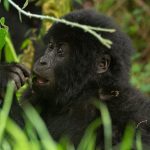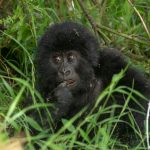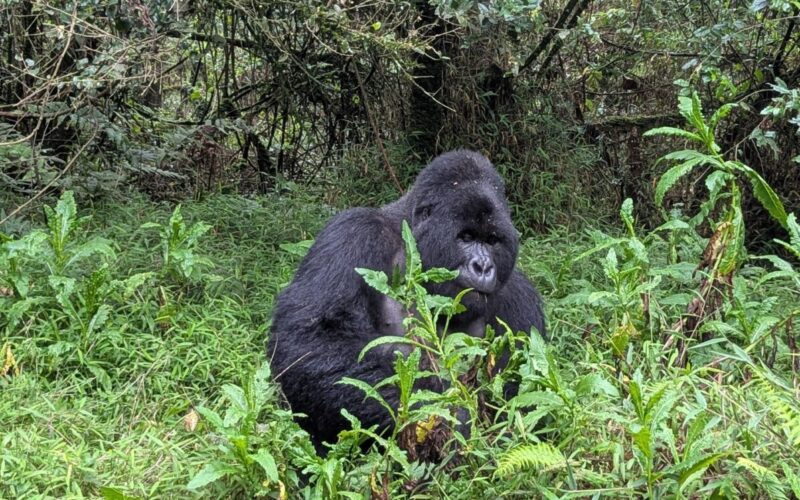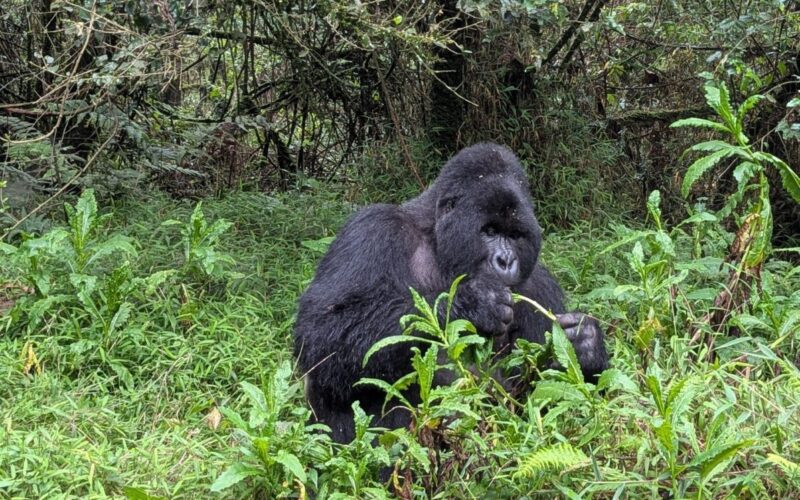
Why Is Gorilla Trekking in Rwanda So Expensive?
February 26, 2025
How Many Days for Gorilla Trekking in Rwanda?
February 28, 2025Is Uganda or Rwanda Better for Gorilla Trekking?
Is Uganda or Rwanda Better for Gorilla Trekking? Gorilla trekking is an extraordinary experience that allows travelers to come face-to-face with the endangered mountain gorillas in their natural habitat. The two most famous countries for gorilla trekking are Rwanda and Uganda. Both offer unique experiences, stunning landscapes, and remarkable wildlife encounters, making the decision between the two a common dilemma for travelers. In this detailed comparison, we explore key aspects such as accessibility, trekking experiences, permit costs, wildlife conservation, and accommodation options to help you decide whether Uganda or Rwanda is better for gorilla trekking.
Overview of Gorilla Trekking Destinations in Uganda and Rwanda
Uganda and Rwanda both house significant populations of mountain gorillas, but they offer different trekking experiences.
- Rwanda: Gorilla trekking in Rwanda is centered in Volcanoes National Park, located in the northwest of the country. The park is part of the larger Virunga Massif, which spans across Rwanda, Uganda, and the Democratic Republic of Congo (DRC). Rwanda is known for its excellent infrastructure and accessibility, making it one of the most popular destinations for gorilla trekking.
- Uganda: In Uganda, gorilla trekking takes place primarily in Bwindi Impenetrable Forest and Mgahinga Gorilla National Park, both of which are situated in the southwestern part of the country. Bwindi Impenetrable Forest is a UNESCO World Heritage Site, and it is home to over half of the world’s remaining mountain gorillas. Uganda offers a more remote and less commercialized trekking experience, attracting travelers who seek a deeper connection with nature.
Trekking Experience and Terrain
The trekking experience in both Rwanda and Uganda is exceptional but differs in terms of terrain, ease of access, and the level of physical challenge.
- Rwanda: Rwanda’s Volcanoes National Park is relatively more accessible and offers a smoother trekking experience. The park’s trails are well-maintained, and trekking is generally easier compared to Uganda. The terrain is less rugged, with volcanic mountains providing a more manageable hike for most visitors. The gorillas in Rwanda’s Volcanoes National Park are typically found at higher altitudes, but the hiking conditions are usually easier due to better paths and infrastructure.
- Uganda: Uganda’s Bwindi Impenetrable Forest offers a more challenging trekking experience. The terrain here is much steeper and more densely forested, which means that trekkers may face more physically demanding hikes. The thick forest, muddy trails, and variable altitudes make trekking in Uganda more strenuous compared to Rwanda. However, this also makes for a more immersive, rugged, and raw wilderness experience for those seeking a deeper adventure.
Gorilla Trekking Permits: Price and Availability
One of the main factors that influence the decision between Uganda and Rwanda is the cost of the gorilla trekking permits, which play a significant role in the overall cost of the safari.
- Rwanda: As of 2025, Rwanda’s gorilla trekking permits cost $1,500 per person per day. While this price is higher compared to Uganda, the premium cost is justified by the country’s well-developed infrastructure, excellent guiding services, and smooth trekking conditions. Rwanda’s permit price also includes the high level of support for wildlife conservation and community development, making it a more expensive, but also a more seamless, option.
- Uganda: Uganda’s gorilla trekking permits are more affordable, priced at around $800 per person per day. This makes Uganda an attractive option for those seeking a more budget-friendly trekking experience. Despite the lower cost, Uganda offers an equally incredible wildlife experience, with the added bonus of fewer tourists in comparison to Rwanda. The difference in permit prices also reflects the fact that Uganda’s infrastructure is still developing compared to Rwanda’s, which may lead to a more rustic, but equally rewarding, experience.
Accessibility and Travel Logistics
Both Rwanda and Uganda are accessible by air and road, but there are differences in terms of ease and convenience.
- Rwanda: Rwanda is often considered easier to access, especially for international travelers. The Kigali International Airport is well-connected to major global cities and serves as the gateway to gorilla trekking. Kigali is just about a 2-3 hour drive from Volcanoes National Park, making it a more convenient destination for those with limited time. The country’s infrastructure is modern, with good roads and reliable transportation options, which helps streamline the overall travel experience.
- Uganda: Uganda’s Entebbe International Airport is also an international hub, but it is further away from the trekking locations. Bwindi Impenetrable Forest is approximately a 7-10 hour drive from Entebbe, depending on road conditions. Alternatively, you can fly to one of the nearby airstrips, such as in Kihihi or Kihoho, but these flights can be expensive and often limited in availability. The long distances and rough roads may make Uganda a less convenient choice for those with limited time or those who prefer smoother travel logistics.
Wildlife Conservation Efforts
Both Rwanda and Uganda have made significant efforts to protect and conserve the mountain gorillas, contributing to the steady rise in the gorilla population over the past few decades. However, there are notable differences in their conservation models.
- Rwanda: Rwanda has been lauded for its successful conservation strategies, particularly in the area of anti-poaching efforts and the involvement of local communities in tourism. The revenue generated from gorilla trekking permits is invested back into conservation and community development projects. Rwanda’s commitment to preserving its natural heritage, including stringent regulations on human-gorilla interaction, ensures that visitors have a minimal impact on the gorillas and their environment.
- Uganda: Uganda also has an impressive conservation record, with the Uganda Wildlife Authority (UWA) working tirelessly to protect the gorillas. The revenue from permits supports the Bwindi Impenetrable Forest and Mgahinga Gorilla National Park ecosystems, alongside conservation initiatives such as habitat restoration and anti-poaching patrols. Uganda’s approach is often seen as more community-centered, with local people benefiting directly from tourism.
Both countries have played a crucial role in increasing the mountain gorilla population and ensuring their long-term survival, making either destination a worthwhile choice for eco-conscious travelers.
Accommodation Options
Accommodation options in both Rwanda and Uganda cater to a wide range of preferences and budgets, from luxury lodges to more modest options.
- Rwanda: In Volcanoes National Park, accommodation is relatively upscale, with a wide selection of luxury lodges and boutique hotels. Some of the most famous properties include Bisate Lodge and Sabyinyo Silverback Lodge, offering world-class service and stunning views of the Virunga volcanoes. The lodges in Rwanda are generally known for their high standards, modern amenities, and close proximity to the trekking starting points.
- Uganda: Bwindi Impenetrable Forest offers a more diverse range of accommodations, from budget campsites to mid-range lodges and high-end eco-lodges like Clouds Mountain Gorilla Lodge and Buhoma Lodge. While luxury options are available, the overall experience in Uganda is often more rustic and intimate. The less commercialized nature of the region offers a more tranquil and off-the-beaten-path atmosphere.
Conclusion: Which Is Better for You?
Both Rwanda and Uganda offer unforgettable gorilla trekking experiences, each with its own advantages and unique characteristics. Your choice between the two will depend on your priorities, preferences, and the kind of experience you are seeking.
- Choose Rwanda if: You prefer a more luxurious and accessible trekking experience, with easier terrain, high-end accommodation, and shorter travel times from the capital (Kigali). Rwanda is ideal for those who want a seamless, high-end experience with top-notch infrastructure.
- Choose Uganda if: You seek a more rugged, authentic, and budget-friendly adventure. Uganda offers a more remote and less commercialized trekking experience, with the opportunity to trek through dense, unspoiled forests and interact with fewer tourists. If you don’t mind longer travel times and more challenging terrain, Uganda offers a unique, intimate adventure with equally rewarding gorilla encounters.
At Deks Safaris & Tours Ltd., we offer tailored tours to both Rwanda and Uganda, ensuring that your gorilla trekking adventure is perfectly suited to your needs and preferences. Whether you choose Rwanda or Uganda, you are guaranteed an unforgettable experience with the incredible mountain gorillas.
Luxury Africa Tours & Holidays – Deks Safaris and Tours Ltd
- 6 Days Uganda Adventure Tour
- 6 Days Uganda Safari
- 7 Days Uganda Safari
- 7 Days Uganda Tour
- 8 Days Uganda Safari
- 8 Days Uganda Tour
- 9 Days Uganda Wildlife Tour
- 15 Days Best of Uganda Safari
- 15 Days Ultimate Uganda Safari
- 21 Days Around Uganda Safari
- 21 Days Uganda Gorilla, Wildlife, & Chimpanzee Safari
- 3 Days Bwindi Gorilla Trekking
- Uganda Gorilla Trekking 4 Days Safari
- 4 Days Uganda Luxury Safari
- Double Gorilla Trekking in Uganda and Rwanda
- 5 Days Uganda Gorilla Trekking & Wildlife Tour
- 5 Days Uganda Gorillas & Chimpanzees Safari



